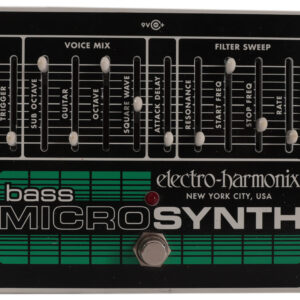Description
The Electro Harmonix Nano Operation Overlord Allied Overdrive Pedal is currently retailing at £85 and it is in stock. Available to be delivered to you by post direct (some charge may apply).The team at Just Pedals think that Electro Harmonix nailed it with the Electro Harmonix Nano Operation Overlord Allied Overdrive Pedal. Electro Harmonix Nano Operation Overlord Allied Overdrive Pedal
We have new and used Electro Harmonix musical equipment available on our website for fast direct delivery from sellers across the UK & Europe.
Electro-Harmonix (EHX) is a legendary effects pedal company founded in 1968 by Mike Matthews, known for pioneering some of the most iconic sounds in music history. Based in New York City, EHX offers a vast range of pedals, from the classic Big Muff fuzz and Memory Man delay to innovative effects like the POG and Freeze. Renowned for their creativity, durability, and affordability, Electro-Harmonix pedals have shaped the tones of countless musicians across genres, from rock and punk to ambient and experimental music.
Just Pedals is a new Guitar Effect Pedals Marketplace – We feature new and used Guitar Effect pedals from different sellers, to purchase online from the UK.
We checked and good news we have it in stock, it has your name on it.
Order today and we will have it with you in a jiffy !
Overdrive is a popular guitar effect that creates a warm, distorted sound by amplifying the signal of an electric guitar, typically using a pedal or an amp’s built-in circuit. The effect simulates the natural distortion that occurs when a tube amplifier is pushed to its limit, creating a rich, harmonic response that adds sustain, warmth, and character to the tone. Overdrive pedals are commonly used to add grit and growl to a clean tone without the harshness of full distortion.
The overdrive effect works by boosting the input signal, causing the amplifier to break up and clip the waveform, resulting in a smooth, musical distortion. This is often more subtle and less aggressive than other forms of distortion, making overdrive pedals ideal for blues, classic rock, and country players who seek a dynamic sound that responds to their playing touch. Overdrive pedals can be used in conjunction with other effects like delay and reverb to shape a more complex, evolving sound. Popular overdrive pedals include the Ibanez Tube Screamer, the Fulltone OCD, and the Boss OD-3, each offering different tonal characteristics, from smooth and bluesy to punchy and aggressive.
Just the latest videos
Just related products
£86.00
Compact, yet feature laden overdrive and distortion pedal Create sounds from ranging boost without the grit and sweet crunch all the way to intensely saturated overdrive and thick distortion 3-position input level switch lets you set the initial inpu…
read more
£48.00 £41.33
Exact recreation of the legendary overdrive circuit Offers a power boost and increased definition to your pedals! Features True Bypass 9-Volt battery included Optional 9.6DC-200BI power supply available
£67.98
Reissue of the 1969 classic Muff Fuzz in a die-cast aluminum box Compact, die-cast aluminum package
£27.99
JOYO Vintage Overdrive guitar pedal with RC4558 chip is a representation of the classic TS808 tone. Producing warmer overtones at quieter volumes when used as a clean volume boost, and can achieve a harsher distortion as gain is increased. True Bypas…
read more




























